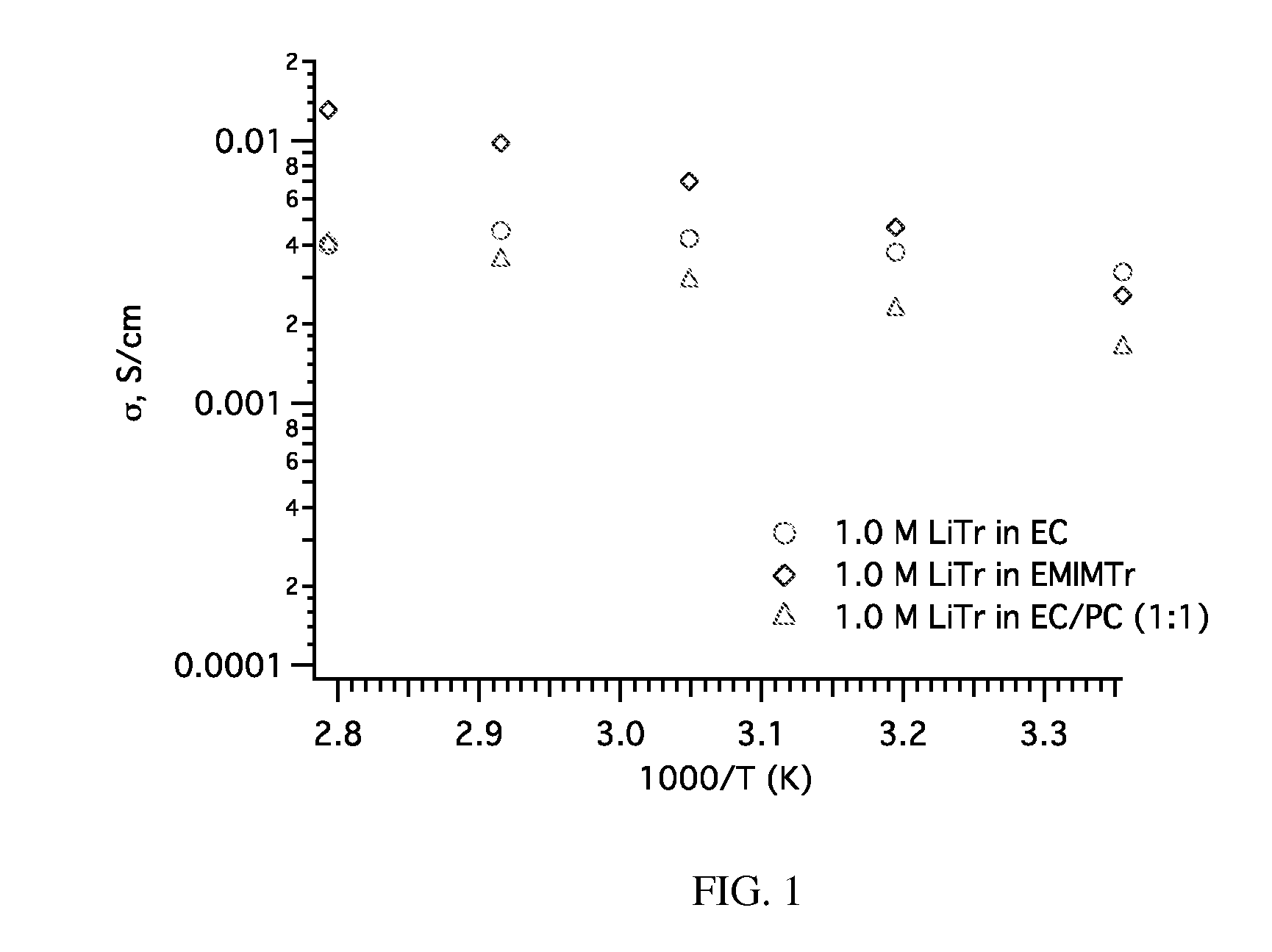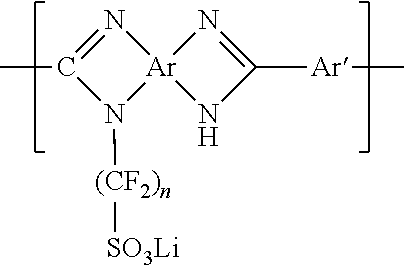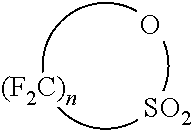Lithium sulfonate polyazole solid polymer electrolytes in polymer electrolyte lithium ion batteries and supercapacitors, and processes of fabrication
a technology of lithium ion batteries and polymer electrolytes, which is applied in the direction of electrolytic capacitors, non-aqueous electrolyte cells, electrochemical generators, etc., can solve the problems of battery combustion risk, battery made using them remains potential fire hazards, and poor mechanical properties for the most part. , to achieve the effect of high lithium conductivity, high lithium transfer value and broad temperature rang
- Summary
- Abstract
- Description
- Claims
- Application Information
AI Technical Summary
Benefits of technology
Problems solved by technology
Method used
Image
Examples
example 1
Imbibing mPBI Films
[0093]A solid polymer electrolyte membrane (SPE) can be prepared by imbibing a commercially available meta-polybenzimidazole (mPBI) with the appropriate solvents and lithium salt combination. Depending on the solvent and salt combination used, the membrane can either take up the solution or dissolve. Approximately 50 mg of mPBI was placed in a vial with 10 ml 1.0 M lithium triflate (LiTr) in ethylene carbonate (EC), (made from 13.2 g EC and 1.56 g LiTr). The solutions were place in ovens at 80° C., 140° C., and 180° C. The membrane imbibed at the lower temperature exhibited a 14% weight gain within the first six hours, attaining a weight gain of 19.5% after 96 hours. The imbibed membrane was plasticized by the EC and appeared transparent orange. The film was stable at temperatures up to 120 C.
example 2
Imbibing pPBI Films
[0094]Para-polybenzimidazole (pPBI) films were prepared by the polyphosphoric acid method that results in a membrane that contains approximately 57% by weight phosphoric acid and 37% by weight water. In order to produce a SPE that can used in a battery, the phosphoric acid must be washed from the membrane. To 2.16 g pPBI washed film, (0.25 g dry equivalent) is added to 1.0M LiTr in EC (made from 5.62 g LiTr dissolved in 47.56 g EC). This solution was heated to 110° C. for 48 hours. Under these conditions, the film maintains its shape and absorbs the LiTr electrolyte solution. The resulting membranes are transparent and orange.
[0095]Conductivity measurements were obtained using a Zahner conductivity test station at five temperatures from 25° C. to 85° C. The samples shown in the graph are all pPBI films imbibed with 1.0 M soltions of LiTr in ethylene carbonate, 1-ethyl-3-methylimidazolium triflate (EMIMTr) and ethylene carbonate / propylene carbonate (EC / PC) made in ...
example 3
Casting Films From 1.0 M Li Salt Solutions
[0099]A SPE can also be prepared by casting a film from a solution of a 1.0 M lithium salt solution of mPBI in an aprotic polar solvent with a cosolvent that is commonly used in battery electrolyte solutions. 20 g mPBI, 12.48 g LiTr, and 67.46 g dry dimethylacetamide is weighed into a 250 ml stainless steel pressure vessel. The vessel is then purged with nitrogen before it is sealed. The bomb is heated to 220° C. with constant agitation for 16 hours then cooled to 60° C. for the addition of the γ-butyrolactone. The solution is then stirred for another 4 hours before a film is cast on a glass plate. The film is allowed to dry in a 60° C. oven for 24 hours. The resulting film is a transparent yellow / orange with a thickness of 25 μm.
[0100]As cast, the resulting film could be handled readily and did not appear or feel wet, but was determined to contain 5.5 weight percent water and 19.1 weight percent solvent by thermogravimetric analysis. After ...
PUM
| Property | Measurement | Unit |
|---|---|---|
| temperature | aaaaa | aaaaa |
| temperatures | aaaaa | aaaaa |
| LOI | aaaaa | aaaaa |
Abstract
Description
Claims
Application Information
 Login to View More
Login to View More - R&D
- Intellectual Property
- Life Sciences
- Materials
- Tech Scout
- Unparalleled Data Quality
- Higher Quality Content
- 60% Fewer Hallucinations
Browse by: Latest US Patents, China's latest patents, Technical Efficacy Thesaurus, Application Domain, Technology Topic, Popular Technical Reports.
© 2025 PatSnap. All rights reserved.Legal|Privacy policy|Modern Slavery Act Transparency Statement|Sitemap|About US| Contact US: help@patsnap.com



